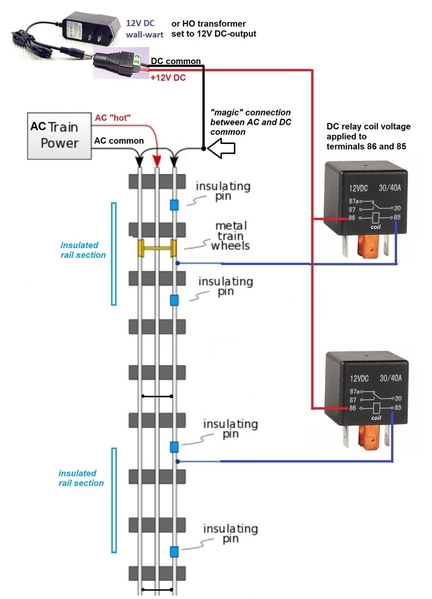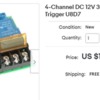@Serenska posted:
... If yes, please let me ask a few complete beginner's questions:
- This is a 12V DC relay. What do you use as your power source? A DC transformer under the table? Something else?
- I'm interested in using relays for an old-fashioned insulated rail-operated block system. What relays would be best for that application? Do those relays need to be AC relays since they will be activated by the wheel's of the train passing over the insulated track sections? Or would the 12V DC relay being discussed here be able to be used?..
The automotive relays under discussion are indeed "DC relays". That is they are triggered by a DC voltage...such as 12V DC in an automotive environment. So if you "only" have AC track voltage or AC accessory voltage then to drive the relay coil you must convert the AC to DC. In general, this means enlisting diodes to convert AC to DC and usually other components to convert the AC voltage to a suitable (e.g., 12V) level to reliably activate the relay coil without burning it out. A suitable source for 12V DC would be an HO-transformer set appropriately...or a 12V DC-output wall-wart which you might have lying around in the garage or attic!
For insulated-rail block control, the "trick" is how to wire up the DC relays into the AC track system.
So let's say you're using a typical automotive relay as being discussed. The relay turns on when you apply 12V DC to its relay coil which is on terminals 86 and 85. For now we'll skip the history lesson of why it's terminals 86 and 85. Above diagram shows how you might do this. The "magic" is to connect the DC common from the 12V DC supply to the AC common of your track transformer. In dozens of OGR threads over the years, this seems to be one of those mind-bending, scratch-your-head, take-it-on-faith, concepts but it is what it is!
So each 12V DC relay coil directly receives 12V DC+ (shown in red). When a metal wheel straddles the outer rails in a trigger section, it provides the DC common to the other side of the relay coil and that relay is now ON.
So once the relay is turned ON, the next question is how do you hook up the relay outputs (the other 3 wires of a typical 5-terminal automotive relay). That's a separate discussion depending on what exactly you mean by block control (some OGR threads call this ATC or automatic train control). Again, I'm focusing on your questions on driving the relays themselves using the insulated rail method.
To peel another layer of the onion. If you do spend the time reviewing OGR discussions on block control using relays, you will find many use DC relay that has a slightly different wiring configuration.
There's a widely available and inexpensive relay "system" as illustrated above. These are 12V DC relays but come in a modular configuration with 1,2,4,8,16, etc. relays on a module. Above shows a 30 Amp version but there is a less expensive 10 Amp version. Your cost-per-relay can be as little as $1 with the 10 Amp version.
Back to the difference. With these relay modules, you don't directly drive the relay coils when the metal wheels straddle the outer-rails of a trigger section. Instead there are amplifiers on the module so you can turn on a relay with a tiny fraction of the current that it takes to directly drive a relay coil. It gets a little techno-nerdy as to why this is a good thing. But cutting to the chase (and this is well covered in previous OGR threads), you can more easily eliminate the flicker/chatter effect where a relay rapidly clicks on/off as a consist enters or leaves the insulated trigger section. That is, lightweight or slightly dirty wheel will makes intermittent contact and the relay(s) rapidly click on/off. This is a your-mileage-may-vary but can be annoying if your block control includes signaling indicators. This method has additional benefits when you need more complex "logic" such as timing delays and the like commonly found in block control applications.
I will stop now since these issues are irrelevant to the original thread topic. ![]()








